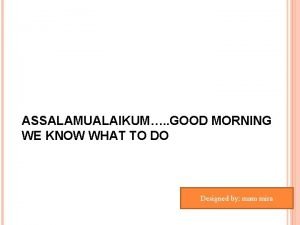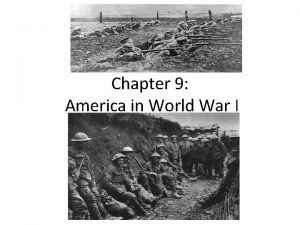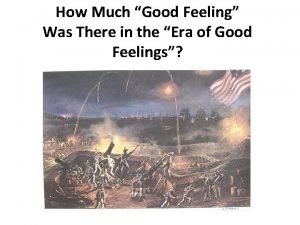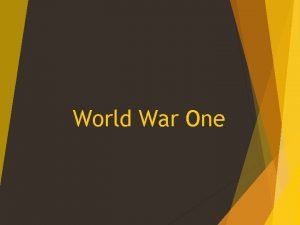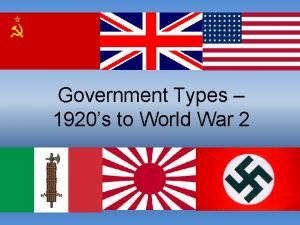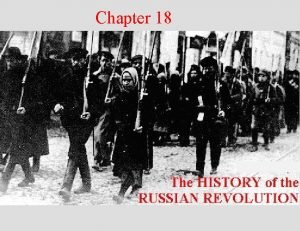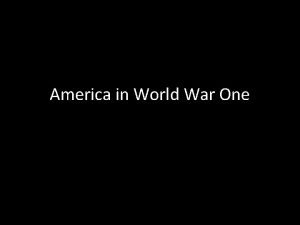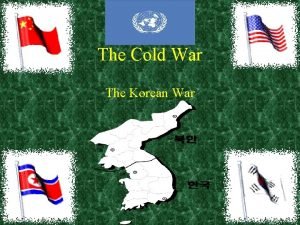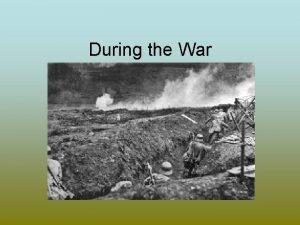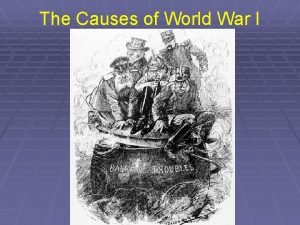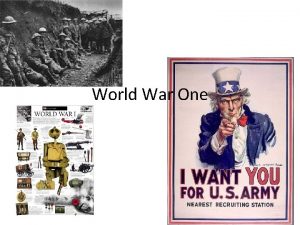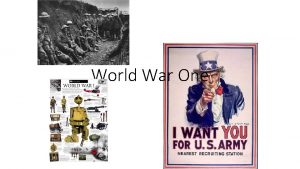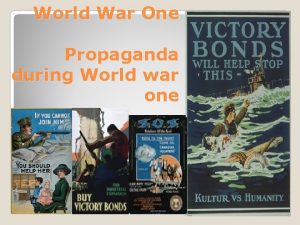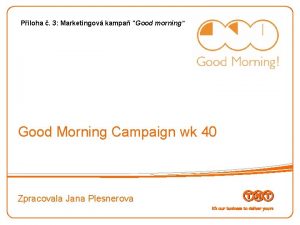America in World War One Good Morning Students






































- Slides: 38

America in World War One

Good Morning Students, silently read “When Would You Go To War? ” in the activities and sources packet

World War I Prior Knowledge • At the top of your notes, write some things you know (or think of) about World War I.

World War One-At a Glance (Contextualization) • Nicknamed the “Great War” • Largest conflict the world had seen up that point • Lasted four years-1914 -1918 • Extremely deadly – 16 million deaths, 20 million wounded • First major conflict after the Second Industrial Revolution-technology much improved

Crime of the Ages

Participating Countries in World War I

Long Term Causes of World War I • • Militarism Alliances Imperialism Nationalism

The Spark • The assassination of Archduke Franz Ferdinand his wife in June 1914. • By August, all major European nations were at war with each other.

U. S. Neutrality In August 1914, President Wilson issued a Proclamation of Neutrality after the war in Europe broke out. • Encouraged Americans to remain neutral in “thought as well as in action”

U. S. Neutrality? Value of US Exports for 1914: Allies: $824. 8 Million Central Powers: $169. 3 Million Value of US Exports for 1916: Allies: $3. 2 Billion Central Powers: $1. 2 Million Value of US loans for 1917 Allies: $2. 5 Billion Central Powers: $27 Million

U. S. Election of 1916








Main Reasons U. S. Enters War • Sinking of Lusitania/unrestricted submarine warfare • Zimmerman Note • Communists take over Russia

Woodrow Wilson, April 12, 1917 • “The world must be made safe for democracy. ” – Woodrow Wilson

Read Wilson’s War Message to Congress, 1917 and answer the questions. Be prepared to discuss.

Read Diverging Interpretations of Why the U. S. went to War. Organize “answers” in most convincing and least convincing.

America Tips the Balance • Selective Service Act – May 1917 – Military Draft – 24 million registered, 3 million called into duty, 2 million serve in Europe – Soldiers enter Europe fresh and idealized compared to their European counterparts – Soldiers are nicknamed “doughboys”-white belts

Over There

What does the song Over There reveal about American identity during wartime?

Essential Question-Day 3 • How did World War One affect American society & the U. S. economy?

Mobilizing Industry U. S. economy not ready for war – had to mobilize. President Wilson ordered nationalization of all railroads under the Railroad Administration Temporary – ended after the war War Industries Board Controlled raw materials, production, prices, & labor relations

Mobilizing Labor Slogan - “Labor Will Win the War. ” More than 1 million women joined the workforce after the U. S. declared war 19 th Amendment ratified just after the war in 1920 Many African Americans migrated north to work in war factories. War Dept. issued a “work or fight” rule in 1918 – drafted if unemployed

Mobilizing Labor National War Labor Board, 1918 created to mediate labor disputes. Discouraged strikes Encouraged higher wages, 8 -hour work day, & unionization. • Union membership in U. S. doubled during the war. • Wages in unionized sectors increased 20% BUT, inflation increased – prices more than doubled Strikes still plagued U. S. – no federal recognition of labor unions

Mobilizing the Economy Food Administration established in 1917 Headed by Herbert Hoover Relied on voluntary compliance “Meatless Mondays” & “Wheatless Wednesdays Encouraged “Victory Gardens” & rationing 18 th Amendment ratified in 1919 – prohibited manufacture of alcohol (conserve grain)

Mobilizing Public Opinion Congress established the Committee of Public Information in 1917. Encouraged public support for the war Voluntary press censorship, propaganda (films, posters), community volunteer organizations Encouraged citizens to report “suspicious” actions or speech

Essential Question (Day 2) Should citizens’ rights be restricted in wartime as a means of protection?

Restricting Civil Liberties in Wartime. Review 1798 – Alien & Sedition Acts Prohibited public criticism of U. S. government 1861 – Lincoln suspends writ of Habeaus Corpus

Restrictions on Civil Liberties • Anti-German hysteria swept the US – fueled by CPI propaganda. Resulted in rampant rumor of spying & sabotage German courses discontinued in many schools Orchestras stopped playing Wagner & Beethoven German foods renamed Frankfurters hot dogs Hamburgers liberty sandwiches Sauerkraut liberty cabbage

Restrictions on Civil Liberties Espionage Act of 1917 Provided fines & imprisonment for persons making false statements, aiding the enemy, inciting military rebellion, or obstructing Selective Service Sedition Act of 1918 Forbade any criticism of the government, flag, or uniform. Targeted Socialists & members/leaders of the IWW - Eugene Debs

Restrictions on Civil Liberties Schenck v. United States Upheld the constitutionality of the Espionage Act Ruling limited free speech when words represented “a clear & present danger. ”

Go to website-Period 7 -WWI and Imperialism and download Sedition in WWI Lesson Plan • HIPP Documents A & B – Historical Context – Intended Audience – Purpose – Point of View Answer the following for Document C 1. When was this law passed? Why did the U. S. gov. pass this law? 2. In your own words, summarize this law. 3. Do you think this law was necessary? Why or why not? Use evidence to support your answer.

ROLES • • PRESENTER-4 LEADER-3 TIME KEEPER- 2 -15 MINUTES RECORDER-1
 Good morning good morning good afternoon
Good morning good morning good afternoon Teacher good morning class student
Teacher good morning class student Good morning class!
Good morning class! Good afternoon dear students
Good afternoon dear students Speech good morning everyone
Speech good morning everyone Good morning i am
Good morning i am Hello hello good afternoon
Hello hello good afternoon Good afternoon buenas tardes
Good afternoon buenas tardes Good morning student
Good morning student Dear boys
Dear boys Good morning students how are you
Good morning students how are you Good morning class how are you today
Good morning class how are you today Good morning my student
Good morning my student Hello good morning madam
Hello good morning madam Responses to hello
Responses to hello Good morning student images
Good morning student images Assalamu alaikum good morning
Assalamu alaikum good morning Good morning teachers and friends
Good morning teachers and friends Good morning, students
Good morning, students Rap of the states
Rap of the states Chapter 9 america in world war 1
Chapter 9 america in world war 1 Good morning ladies and gentlemen
Good morning ladies and gentlemen Good charlotte good morning revival
Good charlotte good morning revival Good morning good lookin
Good morning good lookin Good evening ladies and gentlemen
Good evening ladies and gentlemen Good morning to one and all
Good morning to one and all War good good feeling
War good good feeling World war 1 jeopardy questions
World war 1 jeopardy questions '
' World war one
World war one World war one
World war one World war one
World war one World war one
World war one “we are trying to prevent a world war, not start one”
“we are trying to prevent a world war, not start one” Wwi alliances cartoon
Wwi alliances cartoon Long term causes of ww1
Long term causes of ww1 Good deeds good words good thoughts
Good deeds good words good thoughts You are good when theres nothing good in me
You are good when theres nothing good in me Marian congregation rizal
Marian congregation rizal
















